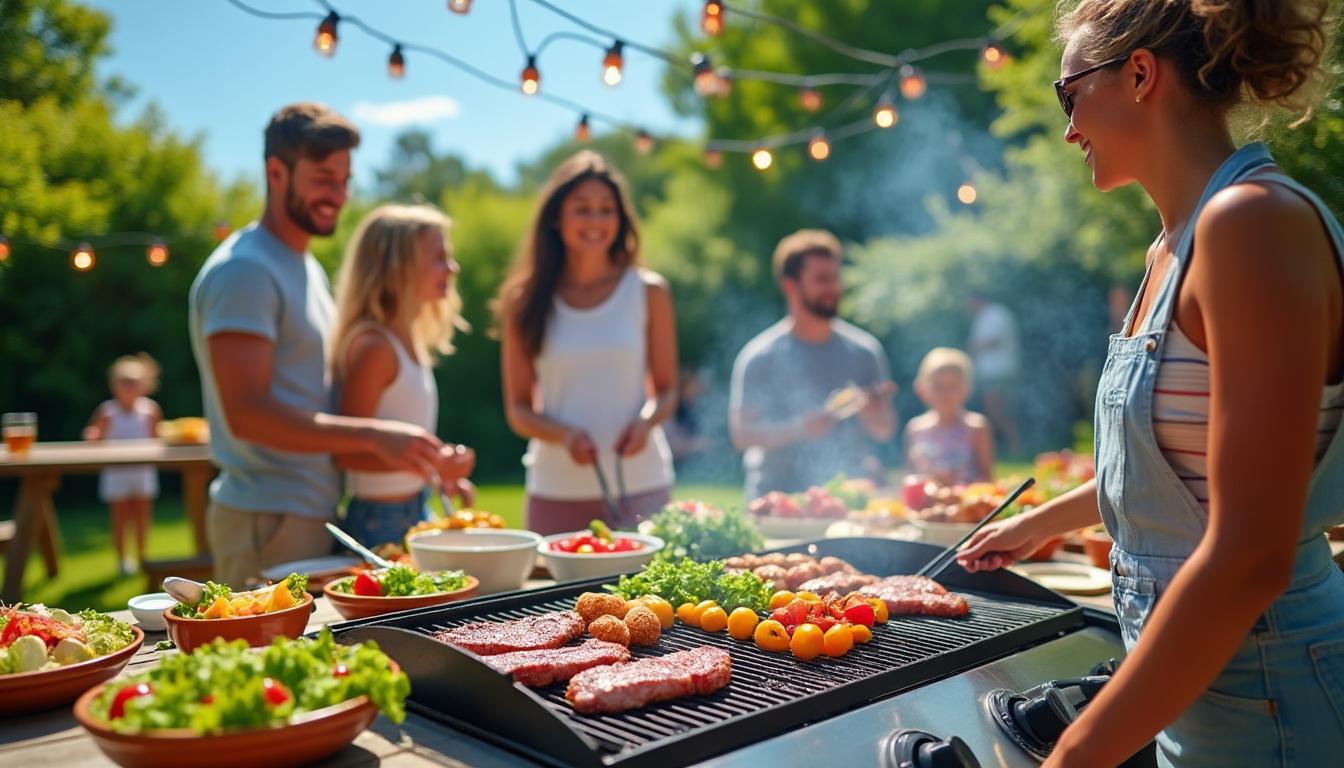As summer arrives and the grilling season officially kicks off, the desire to gather around the barbecue grows stronger. The U.S. Department of Agriculture (USDA) plays an integral role each year, reminding grill lovers nationwide of the importance of food safety in making their cookouts both enjoyable and healthy. As backyard gatherings and neighborhood celebrations become daily events, adhering to proper grilling practices ensures that these festive moments remain free from foodborne illnesses. With the rise in popularity of premium grills from trusted brands such as Weber, Traeger, and Big Green Egg, the bar for outdoor cooking excellence is raised, but so is the responsibility to practice effective food handling and cooking techniques.
USDA Guidelines for Safe Grilling Practices To Prevent Foodborne Illness
The USDA highlights several key food safety practices that every grilling enthusiast should follow. The primary objective is to reduce the risks associated with harmful bacteria such as Salmonella and E. coli, which are often linked to improperly cooked meats or unsafe food handling environments. Whether using a gas-powered Napoleon grill or a pellet smoker from Camp Chef, these foundational tips remain consistent:
- Safe Thawing: Meats and seafood should be thawed either in the refrigerator, submerged in cold water changed every 30 minutes, or immediately cooked if using the microwave method. Never thaw at room temperature to prevent bacterial growth.
- Separate Raw and Cooked Foods: Cross-contamination can be avoided by using separate utensils, plates, and cutting boards for raw and cooked items. Char-Broil grill masters especially benefit from having designated tools for these purposes.
- Proper Cooking Temperatures: Use a food thermometer to ensure meats reach safe internal temperatures. For example, poultry should reach 165°F, ground beef 160°F, and steaks 145°F with a resting period. Brands like Cuisinart often incorporate built-in thermometers for precision cooking.
- Cleanliness: Always start with a clean grill grate—scrape off old residue with a sturdy grill brush. This is particularly important when using smokers such as Masterbuilt or ceramic grills like Big Green Egg.
Incorporating these steps prevents common pitfalls causing foodborne illnesses, creating a safer environment for families and friends. These practices dovetail with other recommended guidelines explained in resources like the Safe Grilling Chicken and Steak guide, underscoring the necessity of vigilance in any seasonal cookout.
| Food Type | Safe Internal Temperature (°F) | Recommended Rest Time (Minutes) |
|---|---|---|
| Poultry (chicken, turkey) | 165 | 3 |
| Ground Beef and Pork | 160 | 3 |
| Steaks and Roasts (Beef, Pork, Lamb) | 145 | 3 |
| Fish and Shellfish | 145 | 0 |
The U.S. Food Safety and Inspection Service (FSIS) reiterates that using certified grills from brands like Weber or Napoleon not only ensures grill quality but also contributes to even cooking, making it easier to reach these ideal temperatures. Moreover, these grills often feature technological enhancements such as temperature gauges and smart apps, reinforcing the safety message.
Choosing The Right Grill and Equipment to Support Food Safety
Investing in reliable grilling equipment is equally crucial to upholding food safety standards. Modern grills from manufacturers such as Traeger and Cuisinart emphasize precision and reliability, which help manage cooking temperatures effectively. Pellet grills like Traeger, for example, allow users to set and maintain exact temperatures, a significant advantage when dealing with delicate meats or prolonged cooking sessions. Hans Grill, with its innovative design, provides an easy-to-clean platform minimizing contamination risks from leftover debris.
Beyond the grill itself, essential accessories enhance safe grilling:
- High-Quality Food Thermometers: Essential for verifying internal meat temperatures. Digital instant-read thermometers reduce guesswork and ensure foods reach USDA-approved temperatures.
- Separate Utensil Sets: Using distinct utensils for raw and cooked meats prevents cross-contamination, an important consideration when cooking large quantities for holiday gatherings.
- Proper Storage Containers: Using airtight containers for marinating and storing leftovers promptly avoids bacterial growth. Brands like Masterbuilt produce handy storage equipment with thermal insulation features.
Selecting the right tools, from reliable grills to precise thermometers, drastically reduces the risks of foodborne illnesses. It is recommended to consult guides such as Thanksgiving Cooking Tips for additional advice on kitchen hygiene and equipment care, relevant year-round but especially pertinent during heavy cooking seasons.
| Grill Brand | Key Safety Feature | Ideal Use Case | Price Range |
|---|---|---|---|
| Weber | Porcelain-enameled, easy-to-clean grates | Family cookouts, versatile grilling | $$ – $$$ |
| Traeger | Precise pellet temperature control | Smoking, slow cooking | $$$ – $$$$ |
| Big Green Egg | Ceramic insulation for steady heat | Grilling, baking, smoking | $$$ – $$$$ |
| Cuisinart | Built-in thermometer and burner control | Compact grilling, beginners | $ – $$ |
Proper Food Handling Techniques During Outdoor Cookouts
Managing food safety, especially in the unpredictable outdoor environment, demands rigorous attention to handling practices. Open-air grills pose unique challenges compared to indoor kitchens due to weather, insects, and the potential for improper food storage. The USDA and food safety experts advocate the following methods:
- Cooling and Storing Leftovers Promptly: Once the grilling session concludes, perishable items should be refrigerated within two hours. Hot weather conditions reduce this window to one hour. Using insulated coolers with ice packs enhances safety, particularly at parks or camping sites.
- Marinating Safely: Always marinate foods in the refrigerator or cooler. Never reuse marinade or use it as a sauce unless it has been boiled to eliminate bacteria.
- Avoiding Cross-Contamination: After touching raw meats, hands and surfaces must be washed thoroughly. When toggling between foods such as vegetables and meats, separate tools and plates are essential.
- Hand Hygiene: Handwashing stations or hand sanitizers should be accessible to all participants throughout the cookout.
Whether grilling burgers on a charcoal Weber or preparing delicate seafood on a Cuisinart, these food handling standards maintain consistent safety regardless of grill type or setting. Incorporating advice from articles like Safe and Delicious Holiday Cookout ensures traditions are sustained without compromising health.
| Food Handling Step | Best Practice | Typical Risk Without Practice |
|---|---|---|
| Temperature Control | Use thermometers, avoid leaving food out >2 hrs | Growth of harmful bacteria |
| Hand Washing | Wash with soap after touching raw meat | Cross-contamination |
| Proper Marinating | Marinate in fridge, discard used marinade if uncooked | Bacterial contamination |
Managing Food Safety Risks with Popular Grilling Meats and Vegetables
Each type of grilling ingredient brings its own set of safety concerns. The USDA emphasizes that vegetables, seafood, poultry, and red meats all have proper handling and cooking requirements to lower foodborne risks. Understanding these nuances is essential when utilizing grills from Hans Grill or Napoleon, renowned for their versatility in accommodating diverse food types.
- Poultry: Undercooking chicken or turkey risks salmonella infection. Internal temperature must reach at least 165°F.
- Beef and Pork: While beef steaks are safe at 145°F with a resting period, ground products demand a higher minimum temperature to reduce pathogens.
- Seafood: Must be cooked to 145°F but also requires freshness attention to avoid spoilage related issues.
- Vegetables and Fruits: Although not a contamination source like meats, raw vegetables should be washed thoroughly and grilled properly to avoid any lingering dirt or microbes.
The rise in plant-based alternatives also calls for strict hygiene and separate cooking zones to prevent cross-contact with animal proteins, a practice that grill owners using brands like Char-Broil or Masterbuilt can implement through modular and accessory-friendly grill designs.
| Food Type | Minimum Safe Temperature (°F) | Special Considerations |
|---|---|---|
| Poultry | 165 | Ensure no pinkness inside, avoid cross-contact |
| Ground Beef/Pork | 160 | Higher temp due to grinding |
| Steak, Roasts | 145 + 3 mins rest | Possible pink center safe if rested adequately |
| Seafood | 145 | Freshness critical, avoid spoilage |
| Vegetables | N/A | Wash thoroughly, use separate grill racks |
This heightened attention to detail during the festive season ensures everyone walks away healthy and satisfied. To deepen understanding of these practices, resources like Food Safety on the 4th of July offer comprehensive insights tailored around high-traffic grilling holidays.
Tips for Storing Leftovers and Preventing Food Waste After Barbecues
Safely handling leftovers is a vital component that many overlook post-grilling. Effective storage can preserve food quality, reduce waste, and prevent foodborne illnesses. The USDA stresses that timely refrigeration is paramount. Utilizing coolers during outdoor activities and transitioning foods to refrigerators promptly makes a significant difference.
Large brands like Char-Broil and Masterbuilt not only focus on cooking technology but also provide accessories like insulated carriers and storage boxes to help home chefs maintain freshness. A few key points for leftover care include:
- Cool cooked foods quickly: Avoid leaving food out more than two hours. When temperatures exceed 90°F, that window shortens to one hour.
- Use shallow containers: Store leftovers in smaller, shallow containers to speed cooling and reduce bacterial growth.
- Reheat thoroughly: When reheating, ensure foods reach an internal temperature of 165°F to kill existing bacteria.
- Label and Date: Mark leftovers for easy identification and consume within 3-4 days to assure freshness.
Consulting guidelines like Store Leftovers to Avoid Waste can provide further strategies to promote sustainable consumption post-celebration.
| Leftover Food Type | Recommended Max Storage Time (Days) | Reheating Temperature (°F) |
|---|---|---|
| Cooked Poultry | 3-4 | 165 |
| Cooked Beef, Pork | 3-4 | 165 |
| Cooked Seafood | 2-3 | 165 |
| Grilled Vegetables | 3-4 | 160 (optional) |
Frequently Asked Questions About USDA Food Safety for the Grilling Season
- Q: How long can grilled food safely sit out?
A: Grilled foods should not be left out for more than two hours. In hot weather (above 90°F), reduce this to one hour to prevent bacterial growth. - Q: What is the safest way to thaw meats before grilling?
A: Thawing in the refrigerator is safest. Alternatively, cold water or microwave thawing is acceptable if the food is cooked immediately after. - Q: Is it necessary to use a food thermometer with all types of grilled food?
A: Yes. Using a food thermometer ensures that meats, poultry, and seafood reach safe internal temperatures to kill harmful bacteria effectively. - Q: Can the same utensils be used for raw and cooked foods during grilling?
A: No. To avoid cross-contamination, always use separate utensils, plates, and cutting boards for raw and cooked foods. - Q: How should leftovers from a barbecue be stored?
A: Leftovers should be cooled and refrigerated within two hours (one hour if hot outside), stored in shallow containers, and consumed within 3-4 days.

